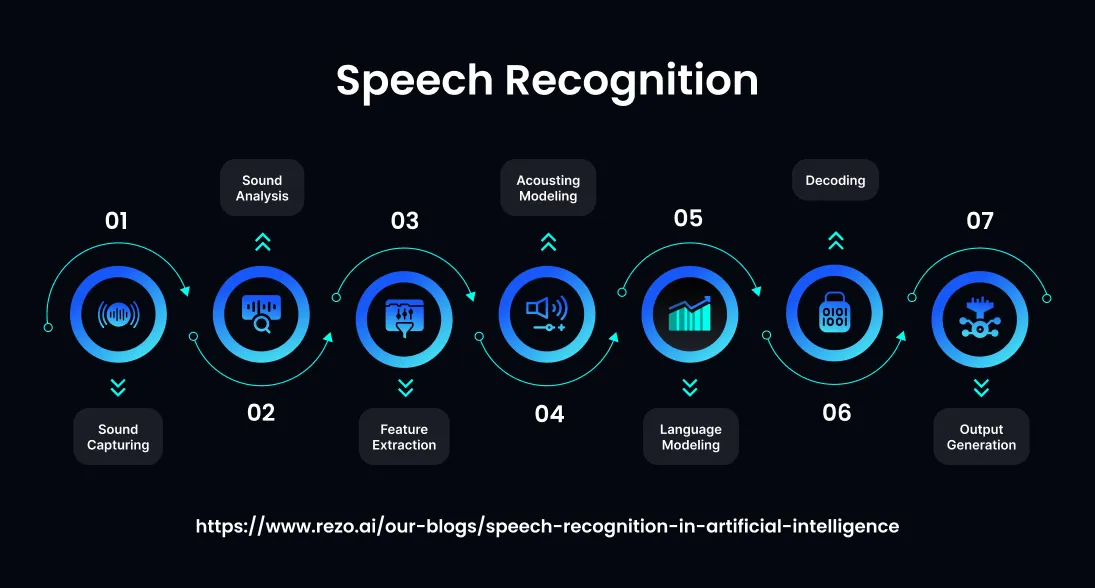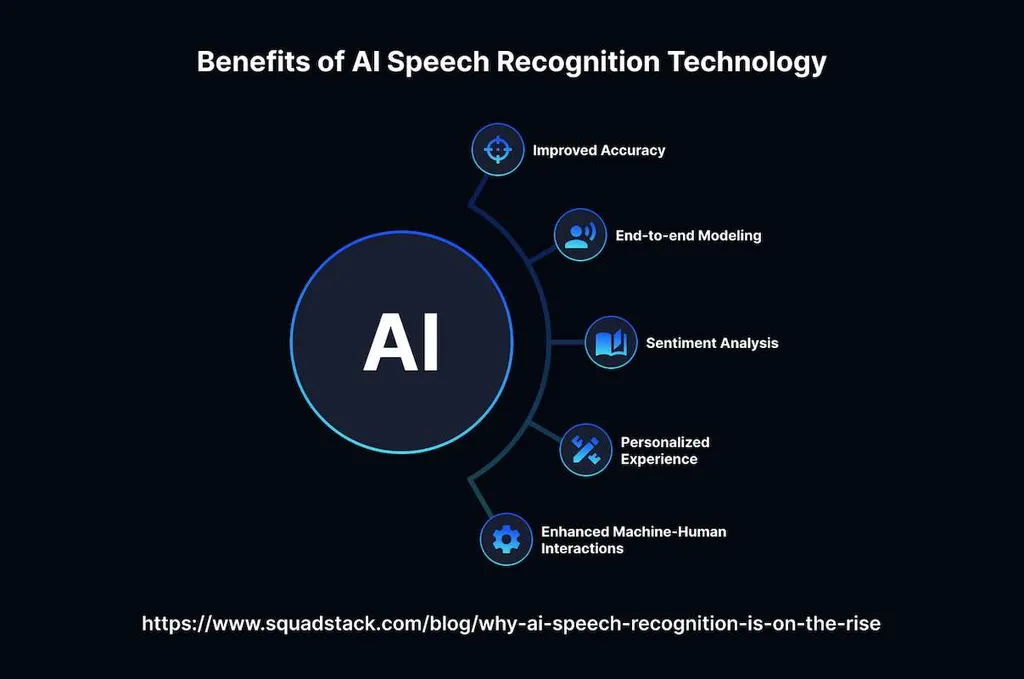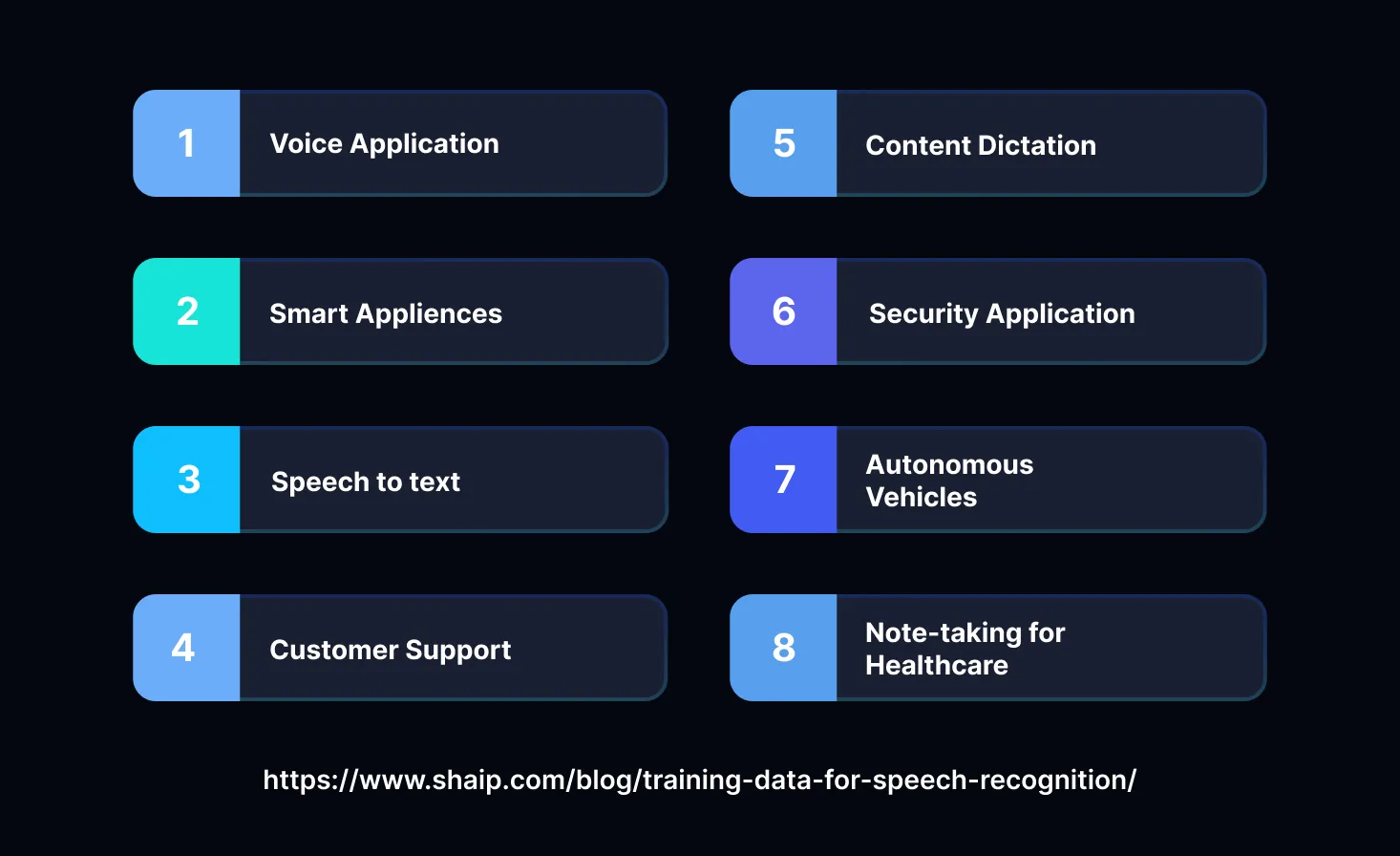The development of Artificial Intelligence (AI) resulted in increased process automation. Companies deploy such solutions to optimize resource usage, provide personalized services, analyze large volumes of data, and extract valuable insights, helping them serve customers better. As 31% of people prefer phone support and 20.5% rely on voice search tools to find the information they need, developers started building solutions that enable computers to interpret human voices. In this guide, we will consider the main traits of AI speech recognition and explore how enterprises utilize AI to interpret consumer queries and provide context-relevant replies.
What is AI Speech Recognition?
This technology allows apps and devices to convert voice to text and interpret it using previously collected data. Automated tools based on complex models are trained to transcribe data with high accuracy and learn from the context. Deploying robotic solutions enables firms to process increased volumes of queries faster and avoid mistakes. Using Automated speech recognition (ASR) software, customer support (CS) teams collect client feedback, process data, and serve clients better.
Powerful voice assistants allow people to communicate with computers. As the accuracy of AI tools continues to increase, new use cases are discovered. Speech-to-text tools are used across many sectors, including healthcare, education, and customer support. They empower enterprises and organizations to provide personalized services 24/7 and serve clients in their native languages.
Even though AI solutions may require additional training to recognize accents and dialects better, their performance gradually improves. Nowadays, they can provide high-accuracy interpretations even when analyzing speech in noisy environments.
How Does AI Speech Recognition Work?

As this technology is still in the early stages of its development, it’s crucial to consider how such tools function to expedite their implementation. The process of analyzing voices involves multiple steps:
- Recognition of words, speech patterns, and content: Companies strive to enhance accuracy and train models to ensure they can identify every word.
- Voice-to-text conversion: AI models convert recorded audio into phonemes, which allows software to process letters and numbers without making any mistakes.
- Interpretation: AI assistants focus on frequently used words, which enables them to determine the meaning of recorded speech and predict the most likely answer relevant to the situation. Bots recognize commands and requests based on data analysis.
Natural Language Processing (NLP) technology facilitates converting data into a format suitable for machines. The usage of speech recognition in AI systems makes it easier to increase their effectiveness and provide solutions relevant to a certain case. Many firms deploy such software to enhance client experience and process queries faster. Utilizing advanced tools, they transcribe calls, online and offline meetings, and all sorts of voice data. Major corporations leverage algorithm-driven apps to provide clients with custom solutions and elevate their experience.
Key Features of Effective ASR
The deployment of ASR software empowers firms to streamline processes and make their routines efficient. Such systems are highly accurate, making them perfect for enhancing client experience. Here are the main features of such tools:
- Real-time transcription: AI solutions instantly convert incoming calls and document them. It eliminates the possibility of errors and empowers agents to make decisions based on analyzed data. Employees no longer need to take notes. Transcriptions are generated quickly, ensuring data consistency. ASR systems facilitate accessing information about past interactions and analyzing client preferences.
- Multilingual support: ASR solutions respond to queries in multiple languages. Firms deploy such tools to expand outreach and target different audience segments. Their usage streamlines communication and fosters trust. AI assistants recognize dialects and use a suitable tone of voice depending on the situation.
- Precision: Machine learning (ML) algorithms increase the accuracy of ASR tools, empowering them to interpret accents. They generate mistake-free transcriptions even in busy environments. AI systems are deployed in various industries, allowing enterprises to achieve sustainable growth.
- Integration with CRM and other systems: Companies deploy ASR products with telephony platforms and advanced software to streamline access to data and achieve higher workflow efficiency. It allows representatives of different teams to access transcripts and optimize performance.
- Customization: Businesses deploy personalized solutions adapted to their needs and configure them to their liking. Robotic assistants communicate in a brand voice and recognize industry-specific jargon.
ASR systems may include centralized dashboards with customizable interfaces. Using them, employees track metrics and increase call center efficiency to get an edge over competitors.
Benefits of AI Automated Speech Recognition

Companies utilize ASR tools to optimize internal procedures and streamline routines. Their deployment facilitates improving customer experience (CX). Besides, such systems have the following benefits:
- Increased productivity: Agents spend less time taking notes, enabling them to prioritize clients’ needs. Automated tools eliminate repetition and reduce average resolution time. It facilitates increasing engagement and building brand loyalty.
- In-depth analytics: ASR products analyze datasets and extract useful insights, helping managers make weighted decisions. It facilitates analyzing customer sentiment, call duration, and other parameters to unveil patterns and solve issues promptly. Managers use the collected data to train agents better.
- Seamless CX: ASR tools support many languages, enabling enterprises to provide top-notch services in a client’s native language. It allows CS teams to circumvent geographical barriers and serve customers regardless of their location or cultural backgrounds.
- Cost efficiency: Task automation simplifies manual operations and helps firms save money. Smaller CS teams enable businesses to diminish operational expenses and optimize resource allocation.
- Complete compliance: ASR software is built in accordance with current regulations. It safeguards client data, which facilitates audits and allows businesses to avoid non-compliance fees.
Advanced telephony systems fitted with ASR tools empower enterprises to avoid data breaches, maintain compliance, and implement result-yielding approaches to process consumer data while following privacy standards.
Use Cases of AI Speech Recognition

ASR solutions are utilized in many industries. Voice-activated assistants enable consumers to place orders, find information, and solve issues with ease. Here are the main applications of such products:
- Call centers: AI bots listen to client questions and deploy cloud models to generate an appropriate response.
- Authorization: Speech patterns are used for biometric purposes, allowing individuals to access information or services using voice as their proof of identity. It enables clients to safeguard sensitive data and avoid storing security codes.
- Financial services: Banks and other institutions utilize AI speech recognition tools to assist clients with their issues. Trained virtual assistants provide information about account balances, interest rates, or special offerings. It allows clients to get replies quickly without searching through self-help platforms.
- Healthcare: ASR apps are compatible with voice-activated gadgets. They enable clients to communicate with staff. Besides, such tools record patient histories, making them accessible.
- Marketing: Content writers create content faster using AI tools. However, training AI models is necessary to avoid frequent typos when writing drafts.
Speech-enabled AI tools let agents prioritize important tasks and upscale the quality of provided services. They help businesses communicate with consumers across multiple channels to strengthen their loyalty to a brand.
Challenges of AI Speech Recognition
Despite the noticeable upsides of deploying ASR software, companies need to invest a lot of money into their integration with old systems. Making the most out of AI tools requires learning how to use AI and cloud technologies. Many firms fail to quickly find the right software to analyze data without compromising the client’s information. Creating algorithms from scratch requires mastering programming languages and discovering how computers perceive human speech. Before using ready-made solutions, businesses need to train them on voice samples. Healthcare organizations should learn about state-level laws protecting medical records before implementing ASR programs.
As hiring a team of experienced developers is too expensive for small and medium-sized businesses and startups, many of them entrust the task of developing custom AI models to third-party providers. MetaDialog builds powerful AI solutions that streamline task automation and improve CS team productivity by 5 times. Get in touch with the company’s managers and discover how to integrate AI speech recognition systems with your software.
